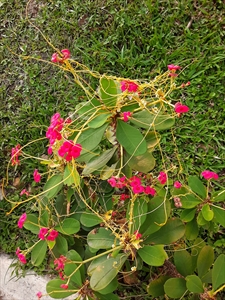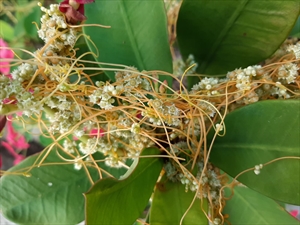Dodder; also called common dodder, field dodder or, in Australia, golden dodder.
Pacific Pests, Pathogens and Weeds - Online edition
Pacific Pests, Pathogens & Weeds
Dodder (Cuscuta) - parasitic plant (426)
Cuscuta campestris. It is a member of the Convolvulaceae family. There are many other species recognised; important ones being Cuscuta pentagona in the US, and Cuscuta europaea in Europe.
Asia, Africa, North, South and Central America, the Caribbean, Europe, Oceania. It is recorded from Australia, Cook Islands, Federated States of Micronesia, Fiji, French Polynesia, Guam, Kiribati, Marshall Islands, New Caledonia, New Zealand, Niue, and Samoa. Originally from temperate North America, but spread has occurred to many tropical and sub-tropical regions.
Very wide. Mainly a pest of lucerne and other legumes (field pea, Phaseolus beans of several kinds, soybean), but also of vegetables, broadleaf crops (e.g., canola, carrot, citrus, potato, sunflower, sugar beet, tomato), ornamentals and weeds.
A parasitic plant without obvious leaves, that has smooth, yellowish branching stems forming a tangled mass over other plants or trees (Photo 1). Leaves are present, but reduced to tiny scales along the stem. Branches form at the scales called 'tendrils', which coil around the stems and leaves of their hosts using suckers ('haustoria') to penetrate and extract nutrients. The combination of smothering and feeding, weakens the host, making it susceptible to other pests, and it may die.
Masses of white or cream, bell-shaped flowers are produced, 3-4 mm diameter, in clusters (Photos 2&3). These flowers form round fruits with four seeds. The seeds last several years in soil. Once they germinate, the stem must make contact with a host within a few days or else it dies. If successful in finding a host, the seedling grows rapidly and forms flowers within 2 weeks.
Spread over short distances occurs as stems grow from one plant to another. Cuscuta also spreads as seed with trash, and in seed cases carried in flood water. Spread of seed can also occur on machinery, and when eaten by cows, sheep, goats, and birds. Long distance spread is by seed that contaminates the seed of commercial crops, for instance, sorghum and forage legumes, such as lucerne and clovers. Contamination of niger (or nyjer) seed (Guizotia abyssinica), commonly sold as bird seed worldwide, is also a possibility.
Cuscuta species have been reported causing severe losses from twenty-five crops species in fifty-five countries, but crop losses generally are poorly recorded. Apart from the reduction in growth and yield of crops, poisoning can occur in horses and cattle that have fed contaminated hay, causing abdominal pain, diarrhoea, weight loss and, occasionally, death.
In parts of Australia, it is considered an environmental weed, growing on plants and trees in grasslands, open woodlands, along banks of rivers and wetlands.
The impact of Cuscuta is greatest where (i) sown as a contaminant of lucerne, clover and niger seed; (ii) where broadleaved crops are grown as perennials; or iii) where vegetables crops and ornamentals are grown in rotations.
Look for a tangled mass of thin, bright yellow smooth stems smothering perennial broadleaved plants. Look for white/cream flowers and fruits with four seeds. Early detection is important: look for dodder in susceptible crops (e.g., sorghum, lucerne, clover) before flowering and seeding begins.
BIOSECURITY
Many countries yet free from Cuscuta have it listed as a noxious weed, and imported seed lots need to be certified free from contamination. Furthermore, in NSW, Australia, seed, fodder or hay contaminated with dodder seed is banned from sale.
CULTURAL CONTROL
Before planting:
- Check areas to be planted and, if Cuscuta is present, remove immediately, before it flowers and sets seed.
- Ensure that seed of pasture legumes are certified free from Cuscuta contamination. The seeds of some of these plants are similar to, e.g., lucerne and niger.
- Till the soil to shallow depth to destroy seedlings before or just after crop establishment. (More costly measure is to destroy Cuscuta using a flame gun are recommended in Australia.)
During growth:
- Continue to be vigilant; inspect, gardens and fields regularly and remove any infestation as soon as seen among ornamentals, crops and weeds.
- It is good practice to map locations where outbreaks occur and to check regularly to ensure that none remains or has regrown from dormant seed or vegetative parts.
- Do not slash infestations and leave the cut material in the crop or weeds: it will reattach itself. Burn the cut material on site, if possible, or take out and burn. Later, check the area for regrowth.
- If machinery has been used in infested fields, clean it thoroughly before moving to Cuscuta-free fields.
- Do not allow livestock to go from infested fields to Cuscuta-free ones. Quarantine for at least 2 days.
- Cut out or pull out the entire infested host plant: Remember, Cuscuta can regrow even from the haustoria.
After harvest:
-
In severe infestations, rotate with grasses or cereals, including maize. Rotations between susceptible and resistant crops should be 3-4 years.
-
Note, if Cuscuta is seen in hay, it should be destroyed as seed may be present which could be spread by animals.
RESISTANT CROPS
Grasses and cereals are not usually hosts of Cuscuta camprestris.
CHEMICAL CONTROL
In Australia, the herbicide metsulfuron-methyl is registered for use on Cuscuta. It is sprayed to run-off, before flowering.
____________________
When using a pesticide, always wear protective clothing and follow the instructions on the product label, such as dosage, timing of application, and pre-harvest interval. Recommendations will vary with the crop and system of cultivation. Expert advice on the most appropriate herbicides to use should always be sought from local agricultural authorities.
AUTHOR Grahame Jackson & Mani Mua
Information from CABI (2020) Cuscuta campestris (field dodder). Crop Protection Compendium. (https://www.cabi.org/cpc/datasheet/17111); and Golden dodder (Cuscuta campestris). NSW WeedWise. Department of Primary Industries, NSW Government. Australia. (https://weeds.dpi.nsw.gov.au/Weeds/GoldenDodder); and from Cuscuta campestris (Golden Dodder). BioNet-Eafrinet. Keys and Fact Sheets. (https://keys.lucidcentral.org/keys/v3/eafrinet/weeds/key/weeds/Media/Html/Cuscuta_campestris_(Golden_Dodder).htm).
Produced with support from the Australian Centre for International Agricultural Research under project HORT/2016/185: Responding to emerging pest and disease threats to horticulture in the Pacific islands, implemented by the University of Queensland and the Secretariat of the Pacific Community.






